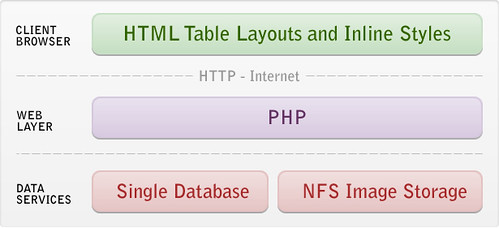DataSift Architecture: Realtime Datamining at 120,000 Tweets Per Second
 Tuesday, November 29, 2011 at 9:12AM
Tuesday, November 29, 2011 at 9:12AM 
I remember the excitement of when Twitter first opened up their firehose. As an early adopter of the Twitter API I could easily imagine some of the cool things you could do with all that data. I also remember the disappointment of learning that in the land of BigData, data has a price, and that price would be too high for little fish like me. It was like learning for the first time there would be no BigData Santa Clause.
For a while though I had the pleasure of pondering just how I would handle all that data. It's a fascinating problem. You have to be able to reliably consume it, normalize it, merge it with other data, apply functions on it, store it, query it, distribute it, and oh yah, monetize it. Most of that in realish-time. And if you are trying to create a platform for allowing the entire Internet do to the same thing to the firehose, the challenge is exponentially harder.
DataSift is in the exciting position of creating just such a firehose eating, data chomping machine. You see, DataSift has bought multi-year re-syndication rights from Twitter, which grants them access to the full Twitter firehose with the ability resell subsets of it to other parties, which could be anyone, but the primary target is of course businesses. Gnip is the only other company to have these rights.
DataSift was created out of Nick Halstead's, Founder and CTO of DataSift, experience with TweetMeme, a popular real-time Twitter news aggregator, which at one time handled 1.1 billion page views per day. TweetMeme is famous for inventing the social signaling mechanism, better known as the retweet, with their retweet button, an idea that came out of an even earlier startup called fav.or.it (favorite). Imagine if you will a time before like buttons were plastered all over the virtual place.
So processing the TweetMeme at scale is nothing new for the folks at DataSift, what has been the challenge is turning that experience into an Internet-scale platform so that everyone else can do the same thing. That has been a multi-year odyssey.
DataSift is position themselves as a realtime datamining platform. The platform angle here is really the key take home message. They are pursuing a true platform strategy for processing real-time streams. TweetMeme while successful, could not be a billion dollar company, but a BigData platform could grow that large, so that’s the direction they are headed. A money quote by Nick highlights the logic in neon: "There's no money in buttons, there's money in data."
Part of the strategy behind a platform play is to become the incumbent player by building a giant technological moat around your core value proposition. When others come a knockin they can't cross over your moat because of your towering technological barrier to entry. That's what DataSift is trying to do. The drawbridge on the moat is favored access to Twitter's firehose, but the real power is in the Google quality real-time data processing platform infrastructure that they are trying to create.
DataSift's real innovation is in creating an Internet scale filtering system that can quickly evaluate very large filters (think Lady Gaga follower size) combined with the virtuous economics of virtualization, where the more customers you have the more money you make because they are sharing resources.
How are they making all this magic happen? Let's see...






















